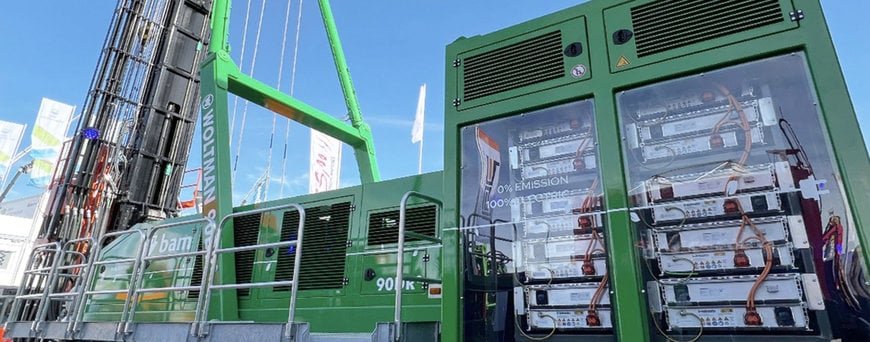www.magazine-industry-usa.com
06
'23
Written on Modified on
Sophisticated battery solution from Webasto moves all-electric Woltman giant drill
Webasto, Editron, and Dieseko collaborate to electrify a 90-ton drilling rig, the Woltman 90DRe, capable of driving 36-meter piles into the ground.

Giant drills are needed on major construction sites around the world. To date, these drilling colossi have been diesel-powered – in terms of both mobility on the construction site and to drive the machines’ various working tools. But the desire to electrify construction machinery does not stop at these heavyweights. Some countries, like the Netherlands, Norway and the US state of California, are demanding zero-emission construction sites as early as 2025 or 2030. Especially nitrogen as well as carbon dioxide emissions shall be reduced as quickly and extensively as possible. This is why Webasto has already implemented solutions for the electrification of various construction machines, now also for a pile drill.
The Idea: divide the battery packs into two
The Woltman 90DRe uses 36 standard battery packs from Webasto. Six of these are permanently installed in the machine, and supply power to a small drive motor that allows the machine to travel short distances on the construction site. The other 30 packs provide the immense capacity of power required for drilling or pile driving. These battery packs can be removed and transported separately. This makes it easier to transfer the machine from one construction site to the next and allows discharged batteries to be replaced with charged ones. Their weight of almost 15 tons provides the necessary counterbalance for the drilling rig.
Well thought-out battery concept
The number of battery packs is designed to provide sufficient power for an average workday on the construction site, i. e. around eight to ten hours. They can then be charged overnight with up to 90 kilowatt per hour. Their energy content is 35 kilowatt hours each –in total, the batteries provide 1.2 megawatt hours of power capacity when fully charged. “Our machines are often the first to arrive on a construction site to start working. The challenge with this machine is to have sufficient grid power available at the site to ensure overnight charging ability. Currently this is not available at every job site, but with the introduction of these types of electric machines, we expect grid power availability will be ramped up”, explains Dirk Smulders, CEO of Dieseko.
Webasto’s batteries are extremely robust (vibration and shock tested to 100 kilonewtons) and are protected by an extra box. The batteries are controlled by a central battery management system in the form of so-called vehicle interface boxes (VIBs). The VIBs from Webasto also serve as a communication interface between the battery system and the vehicle. Moreover, they can be cooled within the system, which guarantees their performance even in hot environments and under continuous load.
Holistic thermal management
To ensure that the batteries always work within their optimum operating temperature range of between 10 and 30 degrees Celsius, Dieseko has also opted for the Plug & Play thermal management system from Webasto. In addition, an individual application of the modular platform "eCabin" for the electrical air conditioning of the driver's cab was installed. This includes a high-voltage compressor for cooling, a high-voltage heater HVH 100 as well as intelligent control via the Cronus control unit. "Our battery thermal management solution ensures the best possible energy conservation in everyday life and a long service life for the battery packs. The eCabin heats and air-conditions the driver's cab. So we solve all thermal tasks at once," explains Lena Beckmann, Director Product Management Battery and Thermo Management at Webasto.
Electric construction machines design the future
The electric versions of the drilling machines might be more expensive to purchase, but when their cost is evaluated over their entire service life, they actually deliver an attractive financial proposition. “On the one hand, diesel is going to become even more expensive, while on the other, there are certain tenders that you can only win these days if you use equipment that ensures zero on-site emissions,” Smulders explains. A further benefit of electric propulsion is that the motor only consumes energy when it is operating. Diesel engines work practically throughout the day, even when they are only running in “standby” mode.
Woltman’s machine in the 90-ton weight class is the first deep drilling rig that Dieseko has electrified in partnership with Webasto. Solutions for further machines are already being planned.
www.webasto-group.com

